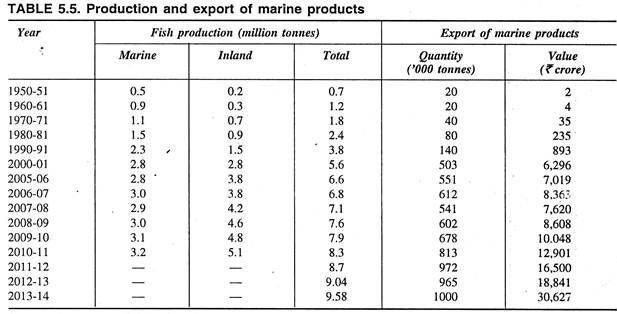In this article we will discuss about Indian Fishery. After reading this article you will learn about: 1. Subject Matter of Fishery Resources and 2. Fishery Development.
Subject Matter of Fishery Resources:
In India, the fishery resources are composed of both inland and marine. Inland fisheries are composed of major rivers and their tributaries, ponds, reservoirs, lakes, canals etc.
In India, rivers are flowing over 17,000 miles and other subsidiary water channels cover more than 70,000 miles, The marine resources include Indian ocean, Arabian sea alongwith a good number of gulf and bays, In India, nearly 1.8 million fishermen are earning their livelihood from fisheries.
Thus, India is now the third largest producer of fish and second largest producer of inland fish in the world. It is also a source of cheap and nutritious food besides being a major foreign exchange earner. Table 5.4 shows the production and export of fishery products in India.
Table 5.5 reveals that total fish production of the country increased from 0.7 million tonnes in 1950- 51 to 2.4 million tonnes in 1980-81, 3.8 million tonnes in 1990-91 and then to 9.58 million tonnes in 2013- 14, of which 5.6 million tonnes came from inland fisheries and 3.8 million tonnes came from marine sources.
Total volume of exports of fishery products increased from 0.20 lakh tonnes in 1950-51 to 1.40 lakh tonnes in 1990-91 and then to 10.00 lakh tonnes in 2013-14. Accordingly, the total value of such exports increased from Rs 2.0 crore in 1950-51 to Rs 893 crore in 1990-91 and then to Rs 30,627 crore in 2013-14.
Inspite of having huge fishery resources, the production of fish in India is not at all adequate to meet its requirements. Contribution of fisheries to net domestic product at 1970-71 prices which was 0.7 per cent of NNP in 1970-71, slightly declined to 0.6 per cent of NNP in 1986-87 and then increased to 1.1 per cent of GDP in 2013-14.
ADVERTISEMENTS:
Despite the huge potential, India produces only 9 per cent of total fish production in Asia whereas Japan contributes about 43 per cent and China contributes 18 per cent.
Fishery Development in India:
In India, the importance of developing fishery resources is realised in recent years. The huge marine resources are not exploited to the fullest extent. As per the estimate of Indian Ocean Expedition, at present India produces only 1 to 8 per cent of total fish production from the Eastern and Western Coast.
With the introduction of modern methods, total production of fish can be increased by 18 times i.e., from the present 2.0 million tonnes to 36 million tonnes.
This will no doubt improve the nutritional standards of the people and also raise the foreign exchange earnings of the country. During the Fifth and Sixth Plan, the government of India put much importance on the development of fisheries.
ADVERTISEMENTS:
The programme of mechanisation of fishing crafts was carried and thus the total number of mechanised boats increased to 20,000 by 1984-85 and the number of commercial deep sea fishing fleet also increased to 85.
For the proper exploitation of marine fish resources, the Government has provided landing and berthing facilities for these fishing crafts at the major and minor ports and also developed some fishing harbours at major ports for deep sea fishing.
Again for the development of inland fisheries the Government has also taken various steps. For popularising fish farming in tanks and ponds, the government sponsored Fish Farmers Development Agencies (FFDAs), since the Fifth Plan and at present about 147 FFDAs is functioning in seventeen states of India.
About 1 lakh hectares of water area has been brought under intensive fish culture and thereby the yield per hectare of water area has increased from 50 kgs in 1970 to 150 kgs at present. During the Seventh Plan the Government has allocated Rs 500 crore for fishery development and set the target of fish production to 4.6 million tonnes by the end of 1989-90.
To achieve this target the Government has introduced the programme of mechanised boats and providing training to the traditional fishermen about the modern fishing technology. With the completion of the Seventh Plan, the total number of mechanised boat is expected to increase to 25,000 and the number of deep sea fishing fleet is to increase to 350.
During the Seventh Plan the government has also set up ‘Fisheries Industrial Estates’ for the first time. These Estates would supply all the necessary inputs like nets, boats, spare parts etc. and also providing landing centres.
The other schemes undertaken by the Government for the development of fishery includes development of brackish-water aquaculture through Brackish Water Fish Farmers’ Development Agencies (FFDAs), introduction of modernised fishing craft to enable fishermen to extend their area of operation and catch pelagic species under the scheme of Development of Coastal Marine Fisheries etc.
A Shrimp and Fish Culture Project is being implemented with World Bank assistance for development of shrimp culture in the states of Andhra Pradesh, Orissa and West Bengal and for increasing inland fish production in Bihar and Uttar Pradesh in addition to these three states.
Thus India has a huge potential for the development of fisheries, both inland and marine. With the growing attention and modernisation of fisheries, it can be expected that the total production of fish would increase significantly in near future.

